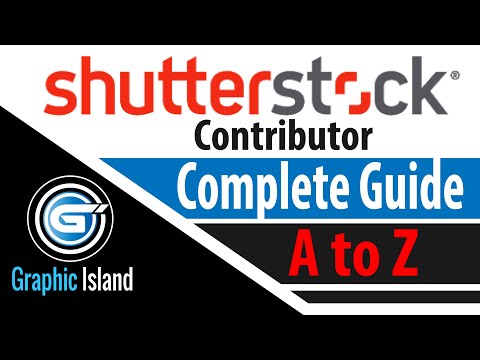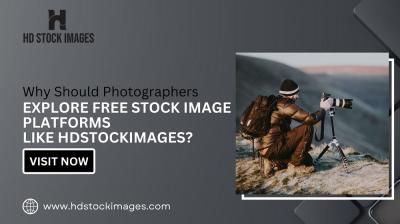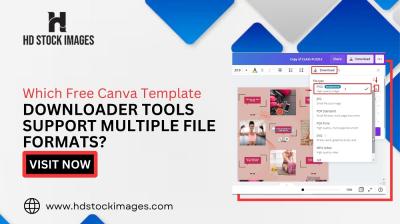1. Introduction
Welcome to our comprehensive guide on how to become a Shutterstock contributor. If you're passionate about photography, illustration, or creating stunning visuals, you're in the right place. In this guide, we'll walk you through the process of contributing your work to Shutterstock, one of the world's leading platforms for stock imagery. Whether you're a seasoned pro or just starting, this guide will provide you with all the information you need to get started, from setting up your contributor account to maximizing your earnings.
Also Read This: How Dailymotion Empowers Emerging Content Creators in 2024
2. Getting Started

If you're ready to embark on your journey as a Shutterstock contributor, you're taking a significant step towards sharing your creativity with a global audience and potentially earning from your work. Here's a detailed guide on how to get started:
1. Create a Contributor Account
Before you can begin uploading your images or videos to Shutterstock, you need to create a contributor account. It's a straightforward process, and it all starts by visiting the Shutterstock contributor platform.
2. Verify Your Identity
Shutterstock takes identity verification seriously to ensure the authenticity of its contributors. You will need to provide the necessary identification documents, such as a driver's license or passport, and some personal information to get verified.
3. Understand the Content Requirements
Shutterstock maintains high standards for the content it accepts. Your images and videos should be of the highest quality and adhere to specific technical guidelines. These requirements include resolution, format, and file size. Be sure to familiarize yourself with Shutterstock's content guidelines before you start uploading.
4. Set Up Your Payment Method
To receive earnings from your contributions, you need to set up your payment method. Shutterstock offers various payment options, including direct deposit and PayPal. Choose the one that's most convenient for you.
5. Explore the Shutterstock Dashboard
Once your account is set up, you'll have access to your contributor dashboard. Here, you can manage your portfolio, track your earnings, and gain insights into the performance of your content. Take some time to explore the dashboard's features and understand how to use them effectively.
6. Start Uploading Your Content
Now comes the exciting part. Begin uploading your images and videos to your Shutterstock contributor account. You can use the web uploader or, for more substantial content libraries, opt for FTP (File Transfer Protocol) uploads. Make sure to add relevant metadata, including titles, descriptions, and keywords, to help potential buyers discover your content.
Image and Video Upload Requirements:
| Content Type | Resolution | Accepted Formats | File Size |
|---|---|---|---|
| Images | Minimum 4 megapixels | JPEG | 3 MB minimum |
| Videos | 1080p or higher | H.264 codec | Up to 4 GB |
These requirements ensure that your content is of the highest quality and meets the standards expected by Shutterstock's customers.
By following these initial steps, you're well on your way to becoming a Shutterstock contributor. In the next sections, we'll delve deeper into optimizing your content, understanding licensing, and maximizing your earnings.
Also Read This: Explore How to Sell Stock Photos on Shutterstock
3. Uploading Your Images

Uploading your images to Shutterstock is the core of your contribution journey. Ensuring that your visuals meet the platform's standards is crucial. Here's a comprehensive guide on the process:
1. Image Specifications
Shutterstock has specific requirements for images to ensure they are of high quality and compatible with various end-user applications. Here are the key specifications:
- Resolution: Your images should have a minimum of 4 megapixels, ensuring clarity and versatility.
- Accepted Formats: JPEG format is the standard for images on Shutterstock, offering excellent compression and quality.
- File Size: Each image should have a minimum size of 3 MB, which helps maintain image quality.
Meeting these specifications ensures that your images have the potential to be used in various professional contexts.
2. The Submission Process
Once your images align with Shutterstock's specifications, you can start the submission process:
- Select Your Images: Choose the images you want to upload from your computer or storage device.
- Title and Describe: Provide descriptive and relevant titles and descriptions for each image. These help customers find your content.
- Keywords: Add appropriate keywords that accurately describe your image. Be comprehensive but avoid irrelevant terms.
- Categorize: Select appropriate categories and subcategories to classify your images accurately.
- Release Forms: If your images contain recognizable people or private property, ensure you have the necessary model and property releases.
- Submit: Review your submission, making sure all details are accurate, and then submit your images for review.
3. The Review Process
Once submitted, your images go through a review process to ensure they meet Shutterstock's quality standards. This process typically takes a few days. Be patient, as it's crucial to maintain the platform's quality reputation.
4. Content Approval and Distribution
If your images pass the review, they become part of your contributor portfolio. They are now available for purchase by Shutterstock's customers. It's important to note that the platform has millions of potential buyers, increasing the exposure of your work.
Image Licensing Options:
Shutterstock offers various licensing options for contributors:
| Licensing Type | Usage | Earnings |
|---|---|---|
| Standard License | For most common uses, such as web and digital media | Standard royalty rate |
| Enhanced License | For high-impact uses, including print and merchandise | Higher royalty rate |
Understanding these licensing options allows you to make informed decisions about how your images are used and the earnings you can expect.
By following these guidelines and understanding the submission process, you'll be on your way to effectively contributing your images to Shutterstock and maximizing your exposure and potential earnings.
Also Read This: How to Save YouTube Shorts for Offline Viewing
4. Image Licensing
Understanding the licensing options for your images on Shutterstock is a crucial aspect of being a contributor. It not only determines how your work can be used but also influences your potential earnings. Let's explore the licensing types and what they mean for you:
1. Standard License
The Standard License is the most common licensing option for Shutterstock images. It allows customers to use your content for a wide range of purposes, including websites, blogs, social media, and more. Here are some key details about the Standard License:
- Usage: Ideal for everyday applications such as online content and digital marketing.
- Earnings: As a contributor, you earn a standard royalty rate for each download of your content under this license.
Understand that customers using images under the Standard License are not allowed to use them for resale or merchandise production.
2. Enhanced License
The Enhanced License offers more extensive usage options, making it suitable for projects with higher visibility and potential profit. Here's what you need to know about the Enhanced License:
- Usage: It's designed for uses that go beyond the standard, such as merchandise, print materials, and TV or film production.
- Earnings: Contributors receive a higher royalty rate for downloads under this license, which can significantly increase your earnings.
With the Enhanced License, your images can be used in ways that generate more income, making it an attractive option for both contributors and customers.
Choosing the Right License
Deciding which license to apply to your images depends on your goals as a contributor. For most images, the Standard License is sufficient and provides a steady stream of earnings. However, for images with exceptional quality or potential for commercial use, opting for the Enhanced License can be more profitable.
It's essential to consider the following factors when choosing a license:
- Image Quality: High-quality, unique, and versatile images may benefit from the Enhanced License.
- Commercial Potential: If your images have a broad commercial appeal, the Enhanced License can attract more customers.
- Your Earnings Goals: Consider your overall revenue goals and how different licensing options align with them.
License Comparison:
| License Type | Usage | Earnings |
|---|---|---|
| Standard License | Everyday applications | Standard royalty rate |
| Enhanced License | High-impact uses, including merchandise and print | Higher royalty rate |
Remember that Shutterstock's licensing options allow you to maximize your earnings potential by tailoring your choices to the quality and marketability of your images. As your portfolio grows and evolves, you can adjust your licensing strategy accordingly to enhance your income as a Shutterstock contributor.
Also Read This: Flickr as Social Media – What You Need to Know?
5. Keywording and Metadata
Effective keywording and metadata are vital for ensuring that your images on Shutterstock are discoverable and attract potential buyers. Metadata not only helps customers find your content but also impacts your success as a contributor. Here's what you need to know about keywording and metadata:
1. Understanding Metadata
Metadata is the information you provide about your images to help describe and categorize them. It includes details like titles, descriptions, and keywords. Accurate and comprehensive metadata is essential because it directly influences search results and customer engagement.
2. Writing Titles and Descriptions
When writing titles and descriptions for your images, be descriptive, concise, and relevant. Here are some tips:
- Relevance: Ensure that your title and description accurately represent the content of the image. Misleading information can lead to customer dissatisfaction.
- Conciseness: Keep your titles and descriptions concise while providing essential information. Avoid unnecessary details.
- Keywords: Use relevant keywords in both the title and description to improve search engine visibility. But don't overdo it – the text should still read naturally.
3. Keywording Best Practices
Keywords are the primary way customers find your images on Shutterstock. The more relevant and strategic your keywords, the more likely your content will be discovered. Here's how to create effective keywords:
- Be Specific: Use specific keywords that accurately describe the image's content, concept, and context.
- Use Synonyms: Include synonyms or related terms to cover a broader range of search queries. For example, "automobile" and "car."
- Avoid Repetition: Don't use the same keywords repeatedly within the same image or across your portfolio. It can be seen as spammy and may reduce your content's visibility.
- Include Location and Concepts: If applicable, add location information and concepts related to the image. This can make your content more appealing to customers seeking specific themes.
Metadata Checklist:
| Element | Guidelines |
|---|---|
| Title | Accurate, concise, and relevant to the image. |
| Description | Provide additional context while keeping it concise. |
| Keywords | Use specific, relevant, and varied keywords. |
Properly optimizing your metadata and keywords increases the chances of your content appearing in customer searches and ultimately boosts your sales potential as a contributor. Regularly reviewing and refining your metadata is essential for maintaining and improving your portfolio's performance on Shutterstock.
Also Read This: how to fill a shape with an image in canva
6. Model and Property Releases
Model and property releases are essential aspects of contributing to Shutterstock, especially when your images feature identifiable people or private property. Understanding these releases and when to use them is crucial for your success as a contributor:
1. Model Releases
A model release is a legal document signed by the person(s) depicted in your images, granting you permission to use their likeness for commercial purposes. Here's what you need to know about model releases:
- When to Use: Always obtain a model release when your image prominently features a recognizable individual. This includes photos of people's faces, distinctive tattoos, and unique characteristics.
- Release Form: The model should sign a release form, which specifies the image's intended usage and the compensation they will receive, if any.
- Legal Protection: Model releases protect you, the contributor, from potential legal issues and ensure that your images can be used for various commercial purposes, including advertising and marketing.
2. Property Releases
Property releases are necessary when your images include private property, trademarks, or recognizable locations. Here's what you should keep in mind:
- When to Use: If your image prominently features private property, recognizable logos, or iconic landmarks, you should obtain a property release. This includes images of buildings, businesses, and landmarks.
- Release Form: Property owners or authorized representatives should sign the release form, granting permission for the image's use and specifying any compensation terms, if applicable.
- Protection and Versatility: Property releases protect you from potential legal issues and allow your images to be used in a wide range of commercial applications, including advertising and editorial purposes.
Release Form Details:
| Element | Explanation |
|---|---|
| Model or Property Owner Information | Include the individual's or property owner's name, contact information, and signature. |
| Image Description | Provide details about the image, its intended use, and any compensation terms. |
| Witness Signature | Having a witness sign the form can add an extra layer of legal protection. |
By obtaining model and property releases when necessary, you not only ensure the legal compliance of your content but also expand its usability, making it more attractive to potential buyers. It's important to keep copies of these releases for your records, as they serve as proof of authorization for the use of your images.
Remember that understanding and properly utilizing model and property releases are essential for both protecting your work and maximizing your earning potential as a Shutterstock contributor.
Also Read This: How to Add Contacts on Telegram Easily
7. Monitoring Your Portfolio
As a Shutterstock contributor, it's crucial to monitor your portfolio to understand the performance of your content, track your earnings, and make informed decisions to optimize your contributions. Here's how you can effectively manage and monitor your portfolio:
1. Contributor Dashboard
Shutterstock provides a user-friendly contributor dashboard where you can access various tools and data to monitor your portfolio. Here's what you can find in the dashboard:
- Performance Metrics: View key performance indicators, including downloads, views, and earnings, to assess the popularity of your images.
- Portfolio Management: Manage your images, add new content, edit existing files, or remove content as needed.
- Earnings Reports: Access detailed earnings reports, allowing you to track your income over time and identify trends.
2. Tracking Your Earnings
Earnings are a significant part of your Shutterstock contribution, and monitoring them is essential. Here's how to keep an eye on your income:
- Earnings Overview: The dashboard provides an overview of your total earnings, helping you gauge your overall financial success as a contributor.
- Detailed Reports: You can generate reports to see which images are performing the best, allowing you to optimize your portfolio based on customer preferences.
- Payout Information: Access information about your earnings payout, including the payout threshold, payment methods, and upcoming payments.
3. Understanding Customer Trends
One of the advantages of monitoring your portfolio is gaining insight into customer trends. By reviewing your most downloaded content and analyzing the types of images that perform well, you can adjust your future contributions to align with customer demands. This can lead to increased sales and earnings over time.
Key Metrics to Track:
| Metric | Importance |
|---|---|
| Downloads | Indicates the popularity of your images and helps you identify top performers. |
| Views | Shows how frequently customers see your content, offering insights into customer interest. |
| Earnings | Reflects your financial success and growth as a contributor. |
By regularly monitoring your portfolio and analyzing the provided data, you can make informed decisions about your content strategy, improve your earnings, and refine your contributions to better serve Shutterstock's customer base. It's an essential aspect of being a successful contributor on the platform.
Also Read This: How to Block YouTube on Your Computer
8. Maximizing Your Earnings
Maximizing your earnings as a Shutterstock contributor requires strategy and dedication. Here are some key tips and strategies to help you make the most of your contributions:
1. Diversify Your Portfolio
Expand your portfolio with a variety of high-quality content. Consider different subjects, styles, and concepts to appeal to a broader audience. Diversification can increase your chances of attracting buyers with different preferences.
2. Consistency is Key
Regularly upload new content to your portfolio. Consistency keeps your content fresh and visible to customers, increasing the likelihood of downloads and earnings. Set achievable goals for the number of images you contribute each month.
3. Trend Awareness
Stay informed about current trends in photography and design. Creating content that aligns with trending topics, seasons, or events can boost your sales. Being ahead of the curve can give you a competitive edge.
4. Optimize Metadata
Pay close attention to your metadata, including titles, descriptions, and keywords. Well-optimized metadata improves the discoverability of your content in customer searches, leading to more downloads and earnings. Continuously refine your metadata based on performance data.
5. Engage with the Community
Shutterstock offers a contributor community where you can connect with other contributors, share experiences, and seek advice. Engaging with the community can provide valuable insights and support for your journey as a contributor.
6. Exclusive Content
Consider making some of your content exclusive to Shutterstock. The platform offers an exclusive contributor program that provides additional benefits, such as increased earnings rates for exclusive content. Evaluate the pros and cons of exclusivity based on your portfolio and goals.
7. Continuous Learning
Stay updated on best practices for stock photography and content creation. Learning about new techniques, technologies, and customer preferences can help you produce more appealing and marketable content.
Exclusive Content Earnings:
| Earnings Level | Standard Content | Exclusive Content |
|---|---|---|
| 10% Earnings Level | $0 - $500 | $0 - $500 |
| 15% Earnings Level | $500 - $3,000 | $500 - $3,000 |
| 20% Earnings Level | $3,000 - $10,000 | $3,000 - $5,000 |
By implementing these strategies and staying committed to your role as a Shutterstock contributor, you can increase your earnings over time. Remember that success often comes with patience and persistence in the world of stock photography.
Also Read This: Learn How to Enhance Image Quality in Photopea
FAQ
Here are some frequently asked questions about contributing to Shutterstock:
- 1. What types of content can I contribute to Shutterstock?
Shutterstock accepts a wide range of content, including photos, illustrations, videos, and music. Ensure your content meets their quality and technical requirements. - 2. How do I get paid as a Shutterstock contributor?
Shutterstock offers various payment methods, including PayPal, Skrill, and direct deposit. You can set your preferred payment method in your contributor account settings. - 3. Do I need to be a professional photographer or artist to contribute?
No, you don't need to be a professional. Anyone with high-quality, original content can contribute to Shutterstock. It's about the quality of your work, not your professional status. - 4. What are the image and video requirements for submission?
Images should have a minimum resolution of 4 megapixels and be in JPEG format. Videos should be at least 1080p with H.264 codec. Make sure to review the content guidelines for detailed specifications. - 5. How long does it take for submitted content to be reviewed?
The review process typically takes a few days. Shutterstock's team ensures that your content meets their quality standards and licensing requirements. - 6. Can I submit the same content to other stock agencies?
It depends on the licensing agreements with other agencies. If you have exclusive agreements, you may not be able to submit the same content to multiple agencies, including Shutterstock. - 7. Do I need to provide model and property releases for all my images?
Model and property releases are only required when your images feature recognizable individuals or private property. Ensure you have the necessary releases to avoid legal complications. - 8. How can I track the performance of my content on Shutterstock?
You can monitor your portfolio through the contributor dashboard, which provides insights into downloads, views, and earnings. Detailed reports are also available to help you analyze your content's performance. - 9. Can I remove content from my portfolio once it's uploaded?
Yes, you can manage your portfolio by adding, editing, or removing content as needed through the contributor dashboard. Keep in mind that removed content may no longer generate earnings. - 10. What should I do if I have more questions or need assistance?
If you have additional questions or require assistance, you can reach out to Shutterstock's contributor support team or engage with the contributor community for guidance and support.
These frequently asked questions should help you get started as a Shutterstock contributor and address common concerns you might have along the way.
Conclusion
Congratulations on completing this comprehensive guide on how to contribute to Shutterstock. We've covered essential aspects of becoming a successful contributor, from setting up your account to maximizing your earnings. As you embark on your journey, keep these key takeaways in mind:
- Diverse Content: Diversify your portfolio with a variety of high-quality content to attract a wide range of customers.
- Consistency: Regularly upload new content to keep your portfolio fresh and visible to potential buyers.
- Trends and Quality: Stay updated on current trends and continually improve the quality of your work to meet customer demands.
- Metadata Matters: Optimize your titles, descriptions, and keywords to enhance the discoverability of your content in customer searches.
- Model and Property Releases: Ensure you have the necessary releases for images featuring recognizable individuals or private property to avoid legal issues.
- Community Engagement: Connect with the contributor community for support, advice, and valuable insights into stock content creation.
- Exclusive Content: Consider making some content exclusive to Shutterstock to benefit from increased earnings rates.
Contributing to Shutterstock offers an exciting opportunity to share your creative work with a global audience and potentially earn from your passion. By following the guidelines and strategies outlined in this guide, you can optimize your success as a Shutterstock contributor and work toward achieving your goals.
Remember that success in stock photography often requires dedication, patience, and ongoing learning. Whether you're a photography enthusiast, a professional artist, or a passionate creator, your journey as a Shutterstock contributor holds the potential for both artistic fulfillment and financial reward.
 admin
admin








